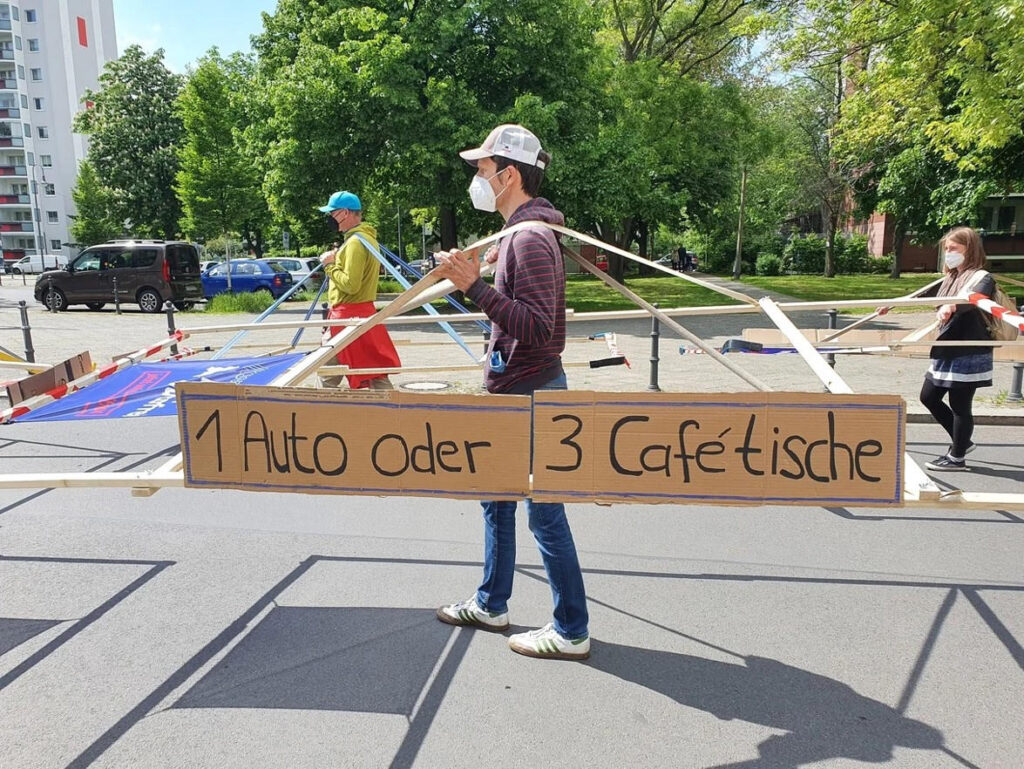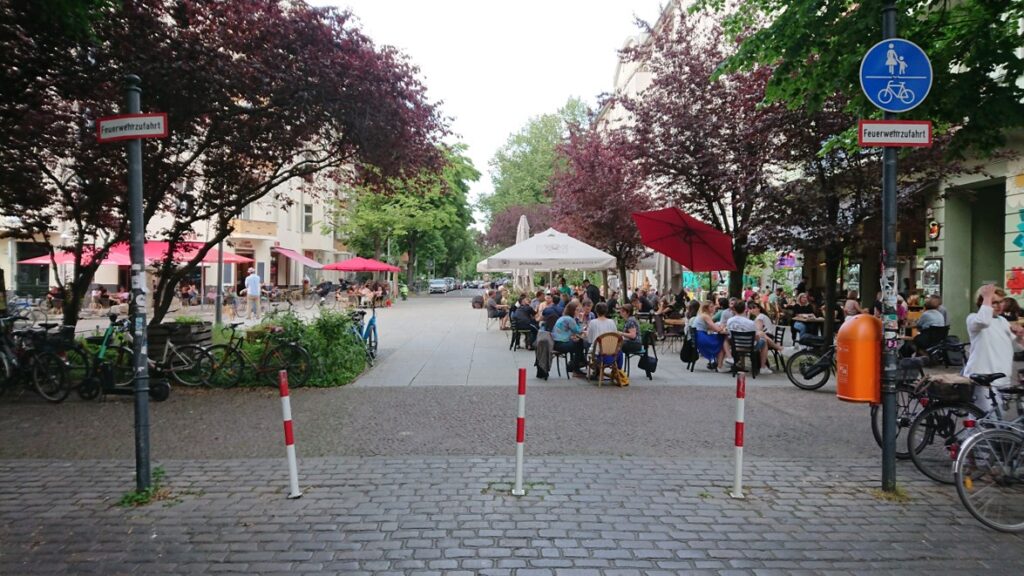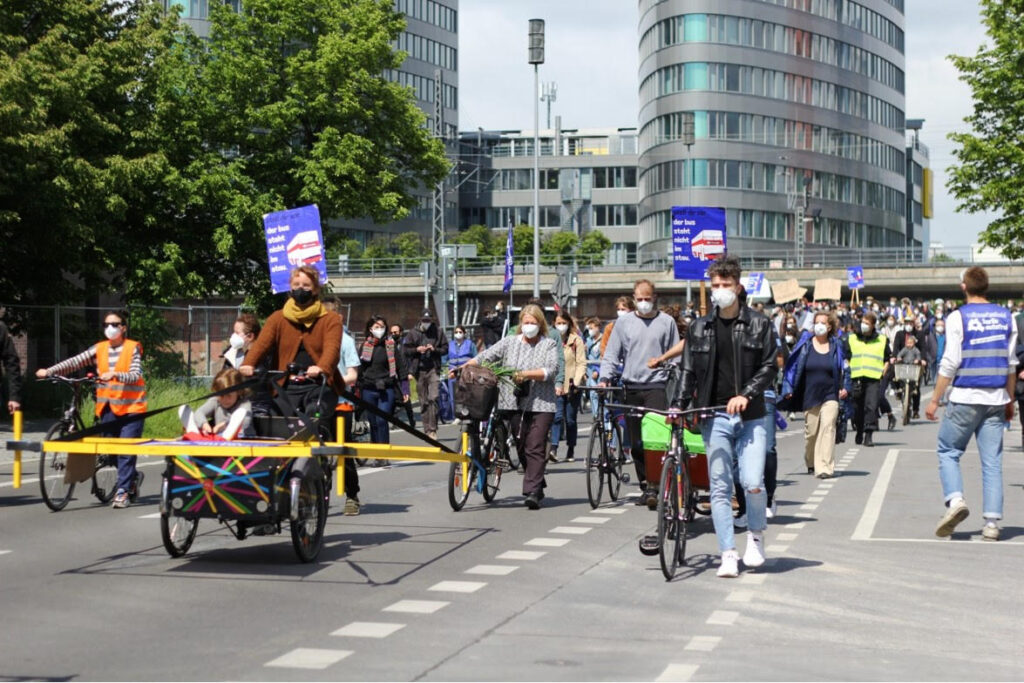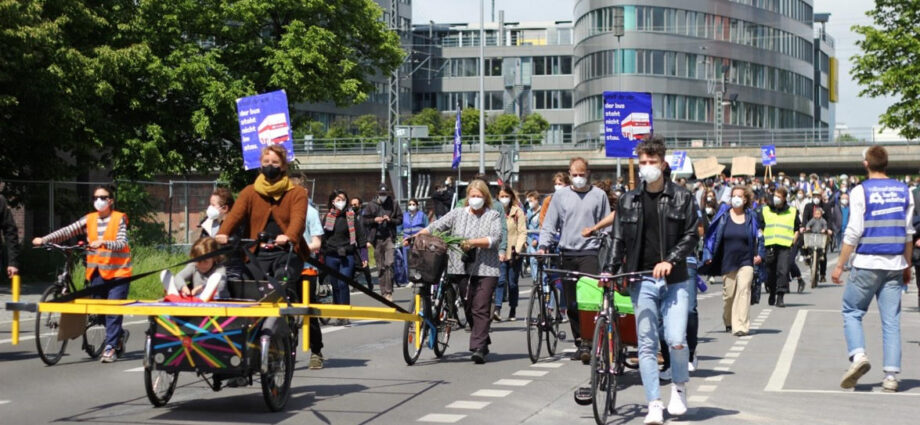Nik Kaestner came to Berlin in 2020 after 38 years of living in the San Francisco (SF) Bay Area in California where he was the director of sustainability at the SF Public Schools. He and his team were responsible for designing carbon-neutral schools, promoting water resilience, reducing waste, encouraging non-car school commutes, and rolling out green schoolyards. The school district managed to reduce its energy use by over 20% and water use by almost 30% in ten years. Their waste diversion rate increased from 38% to 66% during that time.
Now living in Berlin and one of the English spokespeople for Berlin Autofrei, we valued the opportunity to have a dialogue with him and learn more about the work of the organization.
“One thing to point out is that many car-free areas are found in historic city centers, where streets are narrow and car use is difficult to begin with. What we are attempting is not only of a different scale but also in a whole different league. Due to destruction during World War II, Berlin does not have a true historic center and was rebuilt to accommodate the car. It has wide streets and sidewalks and plenty of space that simply needs to be reprogrammed to allow all modes to get around.“
-Nik Kaestner
INTERVIEW WITH NIK KAESTNER, BERLIN AUTOFREI
Can you explain in brief what the initiative Berlin car-free referendum is as well as how long it has been in development?
The goal is to create a car-reduced zone within the S-Bahn ring of Berlin, which would be the largest such zone in the world (88 km2). We believe such a city would be safer (fewer accidents), healthier (less noise and pollution), more livable (more space for retail, gardens, playgrounds, cafes, etc (instead of cars), and more climate-friendly (less CO2). At the same time, it would be more accessible to the two-thirds of Berliners who don’t own a car. Even today, only a quarter of trips are made by personal vehicles in the city of Berlin and less than 20% within the S-Bahn ring. Nevertheless, cars receive 60% of street space while just sitting around over 23 hours per day. In fact, there is ten times as much space devoted to parking as parks and playgrounds. In total, we devote 17 km2 to the 1.2 million vehicles in Berlin, three times the area of Tiergarten Park. This imbalance has to change.

Any updates on the referendum?
We recently submitted over 50,000 signatures supporting our petition to the City of Berlin. The government now has until Spring to either accept or reject our proposal. If it is accepted, we would negotiate legislation. If it is rejected, we would need to collect 170,000 signatures to put it back on the agenda.
What are some of the main criticisms of the referendum?
That we are limiting accessibility, that we are initiating a war against drivers and that our idea is not realistic.
Our arguments:
- Accessibility will go up for the population as a whole, even as car drivers will no longer have free reign. Also, public services, business, and those with mobility impairments could continue to drive on a regular basis. Others would get a limited number of trips per year.
- For decades, cars have dominated the streets and the needs of other users have been ignored. We are simply trying to provide safe access to all types of transportation and speed up public transport.
- Barcelona, Paris and many cities in Benelux have shown us that it is possible to live without cars as the main mode of transportation.
“…many people say we can’t ban cars until transit is better. But I think this is a red herring argument, since Berlin has excellent public transit and because transit cannot achieve its potential until cars get out of the way.”
-Nik Kaestner
What will some of the primary obstacles be to banning private auto use within the S-Bahn ring? What are some changes that can be made (according to Berlin Autofrei) that will help mitigate these changes and facilitate a car-free transition?
The main obstacle is a lack of vision among those who are not as familiar with what other cities have achieved. Education and case studies can help in this regard.
As for practical concerns, it would be important to encourage a reduction in vehicles prior to any new law taking effect, so the pressure on an ever-decreasing number of parking spaces is reduced. This can be achieved through mobility incentives provided to those who give up their vehicle (or don’t use one to begin with).
Longer-term, the redesign of Berlin’s streets will be a multi-decade endeavor. Luckily, the pandemic has shown us that rapid change is possible with “temporary measures” that can be installed relatively quickly.
Can you describe the political dynamics around the support as well as opposition to the referendum?
The Greens are generally in favor but seem to have compromised on their campaign platform as part of current coalition negotiations, although the final agreement has yet to be spelled out. The SPD candidate Giffey seems to take a more conservative approach to the mobility transition. For example, she insists on completing the 16th segment of the A100 highway which the Greens would like to turn into a park and/or bicycle superhighway. She seems to have gotten her way.
Not surprisingly, the FDP (Liberals) and CDU (Conservatives) espouse many of the arguments of those opposed to the initiative: that it will restrict freedom and is not likely to be successful. The far-right AFD is of course against all of this.
“Longer term, the redesign of Berlin’s streets will be a multi-decade endeavor. Luckily, the pandemic has shown us that rapid change is possible with “temporary measures” that can be installed relatively quickly.”
-Nik Kaestner

Berlin has a well-developed and diverse public transit system. Like any system, it can probably always be further improved, for example, increased access for outskirts, etc, but the number of options is high (bus, streetcar, U-Bahn, S-Bahn…). How will this diversity of transit options support a car-free transition in the center?
It is essential, especially for bringing commuters in from the periphery. Thanks for pointing this out, because many people say we can’t ban cars until transit is better. But I think this is a red herring argument since Berlin has excellent public transit and because transit cannot achieve its potential until cars get out of the way. Specifically, that means we need dedicated transit lanes on all streets so that congestion does not slow down buses and streetcars and more room for bicycles in the form of truly separated bike lanes. Both of these will require a reduction in vehicle parking and traffic lanes.
What improvement do you see needing to be made in terms of pedestrian infrastructure and walkability?
Berlin (and maybe Germany) has an odd lack of crosswalks at most intersections which means that cars often receive the right of way when it should be the other way around. This needs to be corrected at every intersection. Secondly, signal timing must be adjusted to allow pedestrians to cross in one go instead of waiting on the median strip. Thirdly, sidewalks that still have large, uneven, old-style pavers need to be upgraded so that those with disabilities can get around easily with a wheelchair or walker. The recent pedestrian law includes a lot of these ideas but now needs to be implemented.
“Two thirds of Berliners don’t own a car. Only a quarter of trips are made by personal vehicles in the city of Berlin and less than 20% within the S-Bahn ring. Nevertheless, cars receive 60% of street space while just sitting around over 23 hours per day. In fact, there is ten times as much space devoted to parking as parks and playgrounds. In total, we devote 17 km2 to the 1.2 million vehicles in Berlin, three times the area of Tiergarten Park. This imbalance has to change.“
-Nik Kaestner

What are Berlin Autofrei’s methods for communicating with the public and advocating?
Social media, press releases, signature gathering, signage…the usual. We are also in conversation with some of the political parties to gather support and build alliances. Similarly, we often organize protests in coordination with like-minded non-profits.
There is a misunderstanding sometimes that “car-free” refers to all vehicles whereas car-free and traffic-reduced areas are typically open to delivery, emergency vehicles as well as special transit for individuals who are disabled. This would also be the case for the area Berlin Autofrei is advocating to be car-free. Has it required a lot of effort or specific communications campaign to convey this to the public?
Yes, the title ‘Car-free’ is provocative, which was our initial goal, but we are already discussing the possibility of adjusting our name in the event of a second signature-gathering campaign to get this point across more readily.
Visit Berlin Autofrei online here
Read more on Berlin by Nik at his blog here

